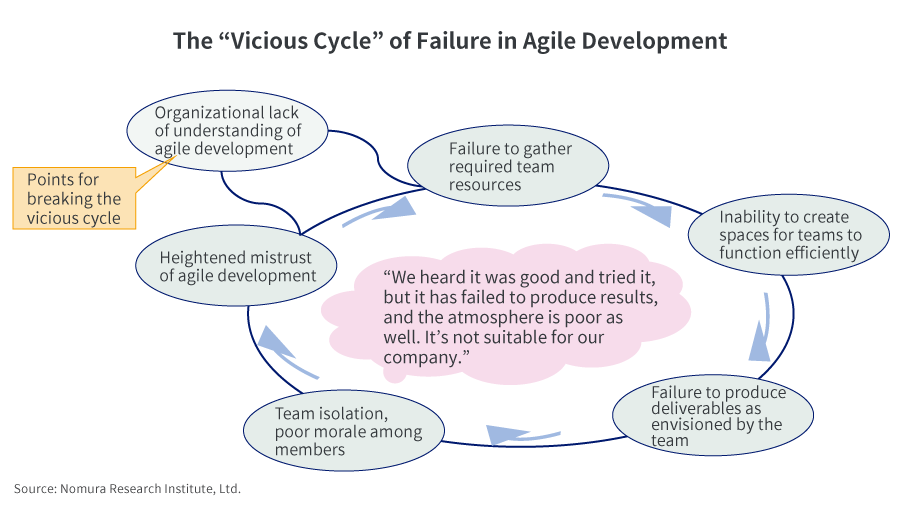
Toward the Realization of Agile Enterprise -- Promoting DX Through Agile Development and Breaking the “2025 Digital Cliff”
Amid the promotion of digital transformation (DX), many IT companies have attempted the agile development adopted by leading companies, but have given up without achieving the expected results and speed. In order to carry out agile development that is actually agile, it is necessary to deepen and permeate the concept and working style at the company-wide level. We spoke with Takafumi Kinoshita of NRI, who has been involved in technical strategy consulting for many years.
Changing development sites that feel closed off
Agile development is a concept that has been around for over 20 years, and it is important to look at it from two angles: agility in thinking, and agility as a method or approach. To put it simply, the former involves trying to change the way we work, always aiming for a better direction. Speaking of IT development sites, overtime and holiday work were once taken as a given. Engineers were prone to exhaustion because they had no decision-making power onsite due to the intentions of the top management and internal regulations. Therefore, the idea has emerged of advancing system development and business development while making flexible decisions on the fly, with the aim of achieving business and individual goals, rather than observing pro-forma rules.
As a method or approach, agile development usually involves a small team of 10 or less (Scrum). Instead of creating features as described in detailed specifications, development is propelled toward its realization once everyone has agreed on what users want based on an understanding of the value that users demand. It is also a feature that people's time is regarded as valuable and each day the work methods are strictly determined. For example, every morning for 15 minutes, necessary information is shared at a meeting (daily scrum) of all members, the allocation of responsibilities and progress is confirmed, and then the work (backlog) is tackled divided into 30-minute intervals. Another feature is that, in doing so, focus is placed on the development of a “Minimum Viable Product (MVP)” that focuses on the minimum necessary features in order to realize the value demanded by users within the constraints of a certain level of inputs (time, cost). That is a big difference from waterfall-style development. It also shortens the development period by eliminating unnecessary work.
Comprehensive transformation from top to bottom
That is the kind of method and approach we take in agile development, but imitating the form alone leads to failure. A commonly seen scenario is where all members have concurrent duties. In that system, not only is it not possible to proceed with work all at once by dividing time, but also work other than team activities (unnecessary work in agile development) also arises, such as reporting to the head of one’s department, which dampens the pace of progress.

In order for agile methods and work styles to work well, it is important for IT company executives to comprehend the characteristics and needs of agile development and to clearly position those things in their digitalization (DX) vision. After that, in the role of a guardian, they also need to communicate the importance of the activities of an agile team within the company and set up a space for information sharing.
For team members, it's important to be able to set their own tasks, backlog design, and scheduling, among other things. Additionally, agile managers, who can be said to be middle management, need to exhibit “servant leadership” such as creating an environment where team members can move at the highest speed, and devote themselves to human resource development. Middle management may be the most difficult thing to transform in this respect, as this style is completely different from management focused on achieving conventional numerical targets. In addition, the “Product Owner (PO)” plays an important role in the team. In many cases, the PO is a person in charge at the client (business division), not an engineer, and POs are extremely important members, being required to determine user value and business value by themselves, clarify the direction of the entire team, and engage the engineers.
Is agile development suitable for Japanese companies?
The concept of agile development itself comes from Toyota's production system. It’s common in Japanese factories to see discussion of the process in which a problem occurred, investigation of the cause, and improvement in a short period of time. At some point, the process has become more sophisticated and complicated, and the organization has become bureaucratic, so I think people are increasingly giving up on such an approach.
For this reason, it seems that in recent years there have been cases where agile development is outsourced entirely, but I do not recommend it. This is because I think it’s important to cultivate know-how in-house and develop human resources. That being said, it is not easy to do agile development in-house, so NRI is supporting that aspect. Specifically, we are conducting educational activities for managers, supporting vision-creation, and building a CoE (Center of Excellence) organization to organize and disseminate accumulated know-how. In addition, for agile development teams, training and coaching to foster an understanding of the role that each person should play, thinking from the perspective of user value, and the behavioral principles of agile development are provided, as well as team participation by NRI engineers.
In light of the coming era, as pointed out by various media, coping with new technologies associated with DX and overcoming the “2025 Digital Cliff” are urgent issues for many IT companies. As approaches to solving these issues, user-oriented thinking (design thinking), reform of system design thinking (system visualization keeping an eye on maintenance and operation), and cultivation of know-how in-house are attracting attention. These things are shared with agile development.
Agile development has the potential to solve these kinds of challenges. From the top management of IT companies to agile development teams, the more people who can act with agility, the quicker progress and results in DX can be seen. Going forward, NRI will continue to support efforts toward the realization of agile enterprise from various angles.

NRI boasts Principals who hold high levels of expertise in specific markets or solutions. NRI Principals, also as leading consultants, lead innovation for society and clients' success. NRI Principals create new businesses, ensure unwavering commitment to projects and are responsible for solving the client's issues.
Profile
-
Takafumi Kinoshita
* Organization names and job titles may differ from the current version.